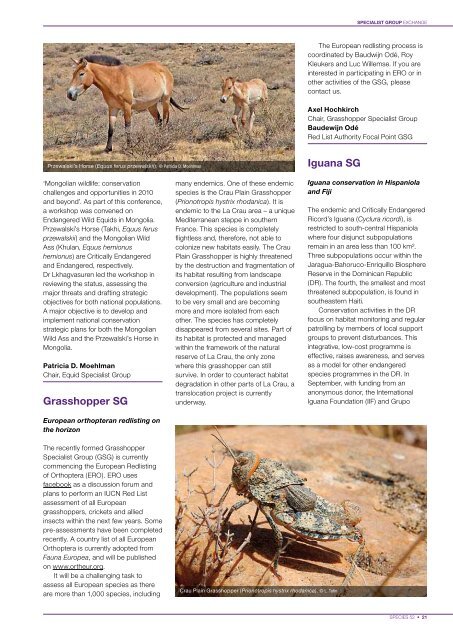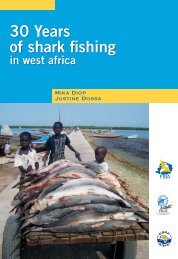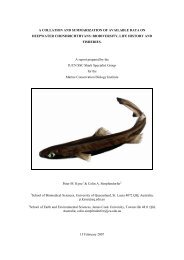Magazine of the species survival Commission specialist Group - IUCN
Magazine of the species survival Commission specialist Group - IUCN
Magazine of the species survival Commission specialist Group - IUCN
You also want an ePaper? Increase the reach of your titles
YUMPU automatically turns print PDFs into web optimized ePapers that Google loves.
<strong>specialist</strong> group exchange<br />
The European redlisting process is<br />
coordinated by Baudwijn Odé, Roy<br />
Kleukers and Luc Willemse. If you are<br />
interested in participating in ERO or in<br />
o<strong>the</strong>r activities <strong>of</strong> <strong>the</strong> GSG, please<br />
contact us.<br />
Axel Hochkirch<br />
Chair, Grasshopper Specialist <strong>Group</strong><br />
Baudewijn Odé<br />
Red List Authority Focal Point GSG<br />
Przewalski’s Horse (Equus ferus przewalskii). © Patricia D. Moehlman<br />
Iguana SG<br />
‘Mongolian wildlife: conservation<br />
challenges and opportunities in 2010<br />
and beyond’. As part <strong>of</strong> this conference,<br />
a workshop was convened on<br />
Endangered Wild Equids in Mongolia.<br />
Przewalski’s Horse (Takhi, Equus ferus<br />
przewalskii) and <strong>the</strong> Mongolian Wild<br />
Ass (Khulan, Equus hemionus<br />
hemionus) are Critically Endangered<br />
and Endangered, respectively.<br />
Dr Lkhagvasuren led <strong>the</strong> workshop in<br />
reviewing <strong>the</strong> status, assessing <strong>the</strong><br />
major threats and drafting strategic<br />
objectives for both national populations.<br />
A major objective is to develop and<br />
implement national conservation<br />
strategic plans for both <strong>the</strong> Mongolian<br />
Wild Ass and <strong>the</strong> Przewalski’s Horse in<br />
Mongolia.<br />
Patricia D. Moehlman<br />
Chair, Equid Specialist <strong>Group</strong><br />
Grasshopper SG<br />
European orthopteran redlisting on<br />
<strong>the</strong> horizon<br />
many endemics. One <strong>of</strong> <strong>the</strong>se endemic<br />
<strong>species</strong> is <strong>the</strong> Crau Plain Grasshopper<br />
(Prionotropis hystrix rhodanica). It is<br />
endemic to <strong>the</strong> La Crau area – a unique<br />
Mediterranean steppe in sou<strong>the</strong>rn<br />
France. This <strong>species</strong> is completely<br />
flightless and, <strong>the</strong>refore, not able to<br />
colonize new habitats easily. The Crau<br />
Plain Grasshopper is highly threatened<br />
by <strong>the</strong> destruction and fragmentation <strong>of</strong><br />
its habitat resulting from landscape<br />
conversion (agriculture and industrial<br />
development). The populations seem<br />
to be very small and are becoming<br />
more and more isolated from each<br />
o<strong>the</strong>r. The <strong>species</strong> has completely<br />
disappeared from several sites. Part <strong>of</strong><br />
its habitat is protected and managed<br />
within <strong>the</strong> framework <strong>of</strong> <strong>the</strong> natural<br />
reserve <strong>of</strong> La Crau, <strong>the</strong> only zone<br />
where this grasshopper can still<br />
survive. In order to counteract habitat<br />
degradation in o<strong>the</strong>r parts <strong>of</strong> La Crau, a<br />
translocation project is currently<br />
underway.<br />
Iguana conservation in Hispaniola<br />
and Fiji<br />
The endemic and Critically Endangered<br />
Ricord’s Iguana (Cyclura ricordi), is<br />
restricted to south-central Hispaniola<br />
where four disjunct subpopulations<br />
remain in an area less than 100 km².<br />
Three subpopulations occur within <strong>the</strong><br />
Jaragua-Bahoruco-Enriquillo Biosphere<br />
Reserve in <strong>the</strong> Dominican Republic<br />
(DR). The fourth, <strong>the</strong> smallest and most<br />
threatened subpopulation, is found in<br />
sou<strong>the</strong>astern Haiti.<br />
Conservation activities in <strong>the</strong> DR<br />
focus on habitat monitoring and regular<br />
patrolling by members <strong>of</strong> local support<br />
groups to prevent disturbances. This<br />
integrative, low-cost programme is<br />
effective, raises awareness, and serves<br />
as a model for o<strong>the</strong>r endangered<br />
<strong>species</strong> programmes in <strong>the</strong> DR. In<br />
September, with funding from an<br />
anonymous donor, <strong>the</strong> International<br />
Iguana Foundation (IIF) and Grupo<br />
The recently formed Grasshopper<br />
Specialist <strong>Group</strong> (GSG) is currently<br />
commencing <strong>the</strong> European Redlisting<br />
<strong>of</strong> Orthoptera (ERO). ERO uses<br />
facebook as a discussion forum and<br />
plans to perform an <strong>IUCN</strong> Red List<br />
assessment <strong>of</strong> all European<br />
grasshoppers, crickets and allied<br />
insects within <strong>the</strong> next few years. Some<br />
pre-assessments have been completed<br />
recently. A country list <strong>of</strong> all European<br />
Orthoptera is currently adopted from<br />
Fauna Europea, and will be published<br />
on www.or<strong>the</strong>ur.org.<br />
It will be a challenging task to<br />
assess all European <strong>species</strong> as <strong>the</strong>re<br />
are more than 1,000 <strong>species</strong>, including<br />
Crau Plain Grasshopper (Prionotropis hystrix rhodanica). © L. Tatin<br />
<strong>species</strong> 52 • 21
















